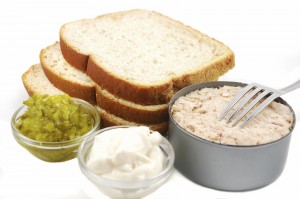
You may have heard about the recent recommendation from Consumer Reports that all pregnant and nursing women avoid all types of tuna, due to concerns about mercury exposure for the unborn baby or newborn. This has a lot of women, and even some doctors, confused about whether to nix all tuna for pregnant or nursing women, or whether it is still safe to consume some tuna varieties.
Until now, public health experts agreed that albacore tuna (the white variety) was unsafe, due to its higher mercury content. But chunk “light” tuna (the darker kind) was always recommended as safe, so long as it was eaten in moderation. In fact, only in June of this year, the Environmental Protection Agency and the Food and Drug Administration issued a joint recommendation that pregnant or nursing women eat a minimum of 8 to 12 ounces (2-3 servings) of low-mercury fish per week. Canned light tuna was included on the list of these safer fish that pregnant or nursing women could consume.
However, researchers at Consumer Reports uncovered that many samples of tuna that they tested, including chunk light, yellowfin and ahi, had as much mercury as shark and swordfish, which the FDA recommends that pregnant or nursing women avoid eating.
Some doctors are still giving the green light to chunk light tuna consumption on occasion, while others are advising women to choose from other fish varieties that are known to be lower in mercury.
Fish high in mercury, to be avoided if you’re pregnant or nursing include:
- Bigeye, ahi, albacore and some light (non-white) tunas
- Swordfish
- Shark
- King mackerel
- Orange roughy
- Marlin
- Tilefish
- Chilean sea bass
- Grouper
- Bluefish
Lowest-mercury fish — that is, safest fish for pregnant/nursing women, include:
- Anchovies, sardines
- Catfish
- Flounder
- Herring
- Mackerel
- Ocean perch
- Pollock
- Wild-caught or Alaskan salmon (canned salmon is safe, too)
- Sole
- Tilapia
- Trout
- Whitefish
Halibut, snapper, freshwater perch and cod are considered to have “moderate” mercury levels, and therefore should be consumed only on occasion, if at all.
(The above is a partial list from the FDA.)
One thing neither Consumer Reports nor doctors want to do is to discourage pregnant or nursing women from eating fish altogether. There are many known health benefits from eating fish, including the facts that it’s ultra-lean protein, it has heart-healthy Omega-3 fatty acids and other important nutrients like calcium, phosphorus, iron, zinc and selenium.
But it’s important for pregnant or nursing women to stick to the low-mercury varieties, as mercury is known to harm the developing brain and nervous system of unborn babies (and young children). Beyond pregnancy and young age, it is still wise for all other people to limit their consumption of high-mercury fish, as mercury in high quantities is toxic for all of us and accumulates in the blood over time. Methylmercury, the form believed to be the most toxic, is readily absorbed into the bloodstream and is especially toxic to the nervous system, gastrointestinal tract and kidneys.
Mercury deposited in waterways originates from industrial processes. It contaminates underwater vegetation that’s eaten by fish.
By Jamell Andrews